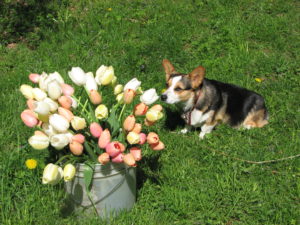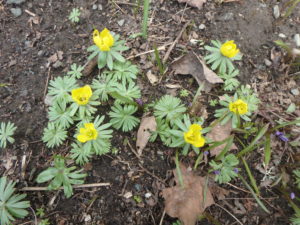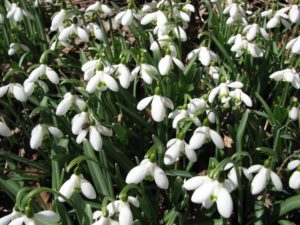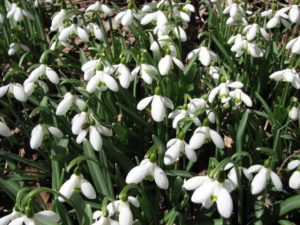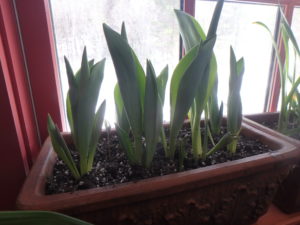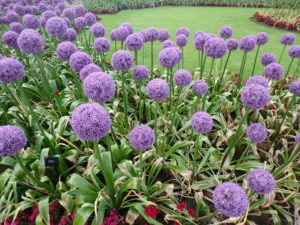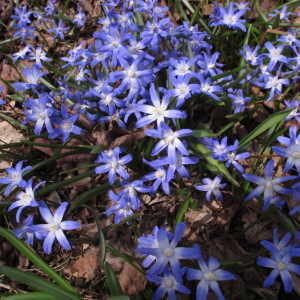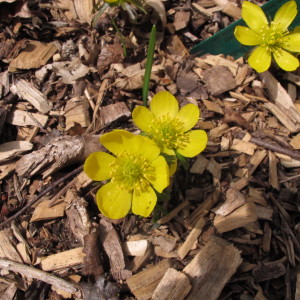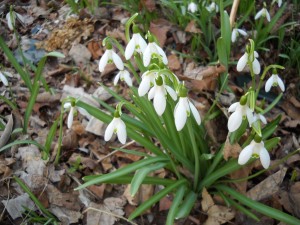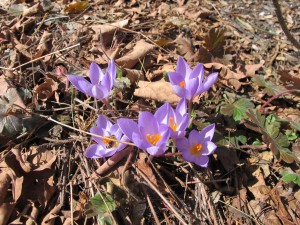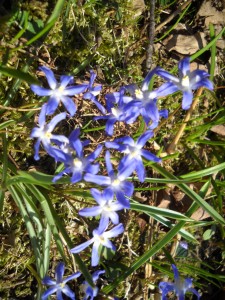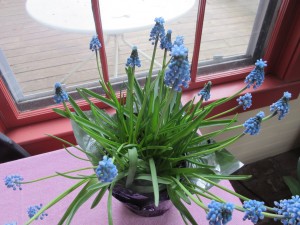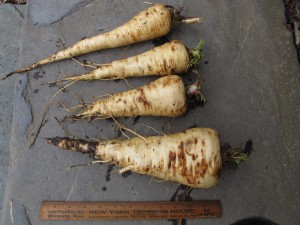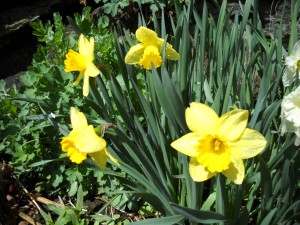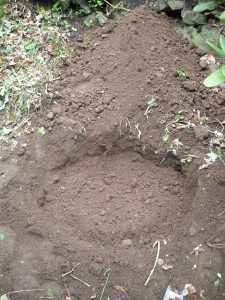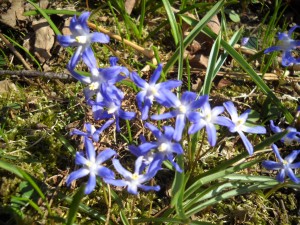The Spring Bulb Flowers
Now is the time to decide where you should plant bulbs next fall. Here’s what I do: I wander around my property each year in the spring to see what spots are bare of bulb flowers. I bring along those white plastic markers used for labeling, and write “add crocus here”, for example. Then in the fall, when it’s time to plant more bulbs I don’t have to rely on my memory to know what to plant, and where.
When planting bulbs, I label what I‘ve planted. That way I’ll see what has performed well, and remember to buy more of the same. For example, I’m always eager to get color in the garden at the same time that the white snowdrops bloom. Two purple-blue bulbs bloom about the same time: Glory-of-the-snow is one plant that overlaps with snowdrops, but is a bit later, as is scilla.
This spring I saw a crocus that was labeled ‘Blue Pearl’, that is blooming with my snowdrops – and before those other two. So I’ll buy 100 of those for fall planting. I bought them at Brent and Becky’s Bulbs– I know because they include tags with each bag of bulbs. And I can order them now for delivery then.
This year I am delighted to see that the winter aconite that produced seed 2 years ago is going to bloom. Last year I recognized the leaves, but it did not produce blossoms. It is a very early bright yellow flower that has one-inch wide, six-petaled flowers. I’ve grown it before but lost it to cold or rodents or poor drainage, and re-planted in other spots. This new patch will give me 50 or so “free” flowers.
I tend to blame bulb failure on drainage problems, not rodents. I mix in lots of compost at planting time and favor hillsides, which helps with drainage. Wet soil is hard on bulbs. Our cats tend to keep rodents away. South facing hillsides are great for early bulbs as the snow melts off weeks earlier than north-facing plots, and drain well.
A bulb plant that I’ve considered fussy is a low-growing iris, Iris reticulata. It is just a few inches tall and has medium-sized blue, purple or (sometimes) yellow flowers. Doing some research I found out why I thought they are fussy: after they bloom, the bulbs divide, producing several little bulblets. These won’t bloom for a few years. So I need to plant some every year until I have a mature colony of them. I also read that they like soil that dries out well in summer, such as in a rock garden or sandy hillside.
My lawn is full of snowdrops that have planted themselves. I assume that they produce seeds that wash into the lawn during summer rains. The bulk of my snowdrops are planted on a hillside above the lawn. But you can plant early spring bulbs in the lawn, too. Just don’t plant daffodils or anything with large leaves because you won’t be able to mow the lawn where they are growing until the leaves yellow and dry off – around July 4th. Bulb plants need to re-charge their batteries, if you will, by getting sunshine and storing energy.
Little bulbs like snowdrops, crocus and grape hyacinths have short leaves that disappear early and won’t disrupt your early mowing. You can always set the lawn mower blades high to protect the leaves if they are still green when you need to cut the lawn.
Grape hyacinths (Muscari spp.) are great little flowers that come in many different shades of blue and purple. I’ve planted many dozens in my day, but find they tend to lose vigor and disappear with time. So I plant them again. Whenever I see grape hyacinths for sale in pots at the grocery store, I buy them. I enjoy them immensely in the house. Later, when the soil is thawed, I plant them outside. I keep the pot in a cool space indoors, as if they get too warm, they flop over.
Tulips I treat like annuals. Why? They do well the first year, but quickly go downhill or disappear in subsequent years no matter what I do. I plant 100 most years in a bed that I reserve for them. Later I plant zinnias in the same bed, so I don’t bother to coddle them. My corgi, Daphne, keeps the deer away.
Daffodils are slightly poisonous to deer and rodents, so they aren’t eaten – and can bloom for years. You can plant them in open woodlands and they will do fine. By the way, if you forced paperwhites this winter, don’t bother planting them outdoors – they’re not hardy here.
I’ve been paying attention to bulb flowers at least since I was 9 years old. I recently found entries in my diary that tell me so. My entry for March 7, 1956, in its entirety was this: “Spring is getting here at last the snow drops are in bud + will bloom in a few days.” Then on April 5 I wrote,” Today our first crocus was in bloom it is very pretty.” As a guy who makes his living writing, I no longer keep a daily journal. I tend to document my life now with a digital camera – and this column. Thanks for keeping me writing!
Henry lives and gardens in Cornish Flat, NH. You may reach him at henry.homeyer@comcast.net. He is the author of 4 gardening books.
Gardening: The Slowest of the Performing Arts
March has been ferocious. None of this “In like a lion, out like a lamb” business. The entire month has been a Tyrannosaurus Rex, if you ask me. I’ve done more roof-shoveling this month than I usually do in a year. My poor snowdrops, usually showing me their noses in early March, are still deep in snow. Sigh. But spring will come. It always does.
Snowdrops, my harbinger of spring, are best planted on a south-facing hillside. That way the snow melts off early, and allows them to push up through the frozen soil. Unlike tulips, their little white flowers look downward, so one must bend over and tip the blossoms up to see inside, which is always the most interesting view of a flower – all those stamens and pistils.
My snowdrops have multiplied over the decades. I don’t know if they move by seed, or if little rodents dig them up and move them around. I suspect it is by seed since they tend to move downhill into the lawn. Fortunately, they get all the sunshine they need to re-charge their batteries by the time I’m ready to mow the lawn. Daffodil leaves, on the other hand, don’t dry up until July, so I don’t plant them in the lawn.
Glory of the snow (Chionodaxa lucilae) is another small early bulb plant that will appear as soon as my snow disappears, and it has multiplied nicely over the years, too. I have it light blue, white and pink. Unlike snowdrops, the blossoms open with their faces up towards the sun – and us.
Scilla siberica, or squill, comes out just a few days after my glory of the snow and has a very intense purple color. Just a couple of inches tall, these small beauties look down, like the snowdrops. These do not multiply quickly, though their clumps or clusters do get more robust over time.
Bright yellow, school bus yellow, I associate with daffodils, and I have plenty of those that bloom in April and May. But before even the earliest are some short yellow blossoms of winter aconite (Eranthis hyemalis). I just learned that they are related to buttercups, which makes sense to me, given their color and flower shape.
Aconite are marginally hardy for me in Zone 4, but last spring I had many tiny ones, clearly first-year plants that developed from seed. I wonder if they will return and bloom for me this year. Such questions will get me outside and in the garden every day, should I ever get old and frail.
Many gardeners have given up on tulips because they are so tasty: to rodents that eat the bulbs, and to deer that consume the buds, blossoms and leaves. Not only that, most gardeners find tulips don’t return, year after year. I think of them as annuals since in year two I get half the number of blossoms I did in year one, and then only half of those come back to bloom in year three. No matter, I love them and plant them.
There are solutions to the tulip dilemma. First, I plant plenty each fall in clay pots and store them in my cold basement. Then, after 4 months of cold storage, I bring the pots into the warmth of the house and they bloom on the window sill. Right now I have some budding up, getting ready to bloom.
At the end of President Clinton’s tenure in the White House I got to interview the White House gardener, Dale Haney. The gardeners had just planted many thousand tulips, a pink one called Hilary Rodham Clinton! I always wondered if the Bush family asked the name of that one, and how President Bush felt about seeing Hilary tulips outside the Oval Office windows, waving at him in the breeze.
.
The White House grounds, I observed, were not only served by many gardeners, but occupied by many large, fat, lazy gray squirrels. I asked Mr. Haney about them. First, he explained, that our tax dollars paid for hundreds of pounds of sunflower seeds to feed the squirrels. A well-fed squirrel is less likely to dig up tulips, he said.
He also explained that the gardeners laid down chicken wire above the bulbs – but an inch or two below the soil surface. Thus if an unusually ambitious squirrel decided to lunch on a Hilary, it would be thwarted by the screening. I’ve tried that, but it’s a lot of work – and my little corgi and two aging cats seem to deter squirrels from digging up any tulips I plant outdoors.
Alliums are bulb plants that vary considerably in size and look according to the species or variety. They’re in the onion family, so not eaten by critters. I was amazed by all the diversity I saw last spring in London at the Chelsea Flower Show, and at Kew Gardens.
I’ve always had a few big ones outdoors, but last fall I planted some in pots to force indoors, as one spectacular variety I simply had to have, Allium schubertii, is only hardy to Zone 6 and would not survive outdoors here. I bought plenty of others that are hardy here in Zone 4 and can’t wait to see them perform.
Gardening – indoors or out – really is the slowest of the performing arts. Plant something, wait, hope. The anticipation, for me, is almost as important as the performance.
Henry is a UNH Master Gardener and the author of 4 gardening books. Reach him by e-mail at henry.homeyer@comcast.net.
Planting Bulbs
After a long winter like this past one, I am always grateful for my spring bulbs. Many of them pop up and bloom on schedule, no matter how cold and snowy the winter was. I’ve been planting bulbs around my property since the early 1970’s, and some of them are still flowering each spring. Others run out of energy and disappear with time. If you haven’t done so yet, now is the time to get some and plant them.
First, let’s look at the basics: what makes a bulb plant survive and flourish? Decent soil. It must be well drained. Soggy soil rots bulbs. If you have a heavy clay soil, it will stay wet and is not a good place for bulbs unless you add compost to the planting hole to help it drain better. Planting on a hillside helps, too, as water will drain off a hillside.
Bulb flowers take shade better than sun-loving perennials. Growing up we had hundreds of daffodils that bloomed along a woodland path behind the house. The leaves got sunshine and re-charged the bulbs before the trees were fully leafed out. Of course if you have plenty of sunshine, all the better.
Some people have had great luck planting daffodils in a grassy field or lawn. I’ve done that, but find that the bulb foliage is still green and producing food for the bulb when the lawn needs to be cut. If you cut the foliage too early, your bulbs won’t perform as well. I like to plant daffodils in flower beds between big clumps of hostas. They can bloom early, and then their dying foliage is hidden by the hosta leaves.
Some gardeners dig a little hole for each bulb, but that seems like too much work for me, even if you have one of those tools that are made for digging small round holes. I’d rather use my shovel to dig one oversized hole, one big enough for the 25 bulbs or more. For large bulbs like daffodils or tulips a hole 24 to 36 inches long and 18 to 24 inches wide is fine for 25 bulbs.
For the big bulbs I dig a hole 6 to 8 inches deep. Then I add compost and some organic fertilizer or “bulb booster” fertilizer and stir it into the bottom of the hole. I place the bulbs on the improved soil, pointy end up, and cover with more improved soil.
What about those hungry, bulb-stealing squirrels? They don’t eat daffodils as they are vaguely poisonous. They may dig a few up to see what you planted, but they won’t eat them. “Yech,” they say, if they inadvertently take a bite.
When I interviewed the White House gardener in 1999 he said they planted thousands of tulips each year, despite the rampant squirrels. He said they planted the tulips and covered them with soil, then put down a layer of chicken wire, then more soil. Oh, and he said they fed the squirrels all winter with cracked corn. Squirrels that are not hungry are less likely to try to steal your bulbs. Squirrel welfare.
Some people have great luck with tulips coming back, but I consider them annuals. In general, I find that the second year only half the tulips come back to bloom, the third year only half of those come back and so on. But I often plant 100 tulips, all one color for a blast of color in spring. I particularly like the tall ones that bloom a bit later.
‘Maureen’ is one of my favorite tulips. She is a 28 inch tall tulip, a creamy white that blooms in May. ‘Menton’ blooms at the same time and is rose-pink with apricot-pink petal edges and is 26 inches tall. Wow. They make a nice mix. I have already ordered 100 of each! That way I’ll have too many flowers, and can give away big bunches of them when they bloom.
If you consider your tulips annuals, you can plant them in your vegetable garden and pull them after blooming. Then you can plant tomatoes or something else there. And if you have a deer problem, you can easily fence a small plot for 100 tulips with 4 poles and some bird netting. If you want to mix them into your flower gardens, plant them where you’ll plant annual flowers. When the tulips are done blooming, it will be time to plant annuals.
The little bulbs are great early harbingers of spring, particularly snowdrops. Snowdrops are small white globes on 4 inch stems. Mine fight through frozen soil in early March. Some years (when we have deep snow) I shovel snow off the hillside where they appear so they can bloom on schedule. Each year I have more, so now, after decades, I have a thousand or more.
Other early bloomers include winter aconite (Eranthis hyemalis), a small up-ward looking 6-petaled brilliant yellow flower. Another favorite of mine is glory-of-the-snow (Chionodoxa luciliae). This is a nice blue, with a yellow eye. It blooms shortly after the snowdrops in April.
I can’t praise the spring bulbs enough. I consider them essential for my wellbeing. So order some, or go to your garden center and buy some. You’ll be glad in a few months.
Henry is on vacation this week and will not be answering questions. His website is www.Gardening-Guy.com
The Spring Bulb Flowers
I’ve been paying attention to snowdrops and crocus since I was 9 years old – I recently found entries in my diary that tell me so. My entry for March 7, 1956, in its entirety was this: “Spring is getting here at last the snow drops are in bud + will bloom in a few days.” Then on April 5 I wrote,” Today our first crocus was in bloom it is very pretty.” I still pay attention to them, and generally note when they come into bloom. Now is the time to decide where you should plant bulbs next fall.
Here’s what I do. I wander around my property each year in the spring to see what spots are bare of bulb flowers. I bring along those white plastic markers used for labeling, and write “add crocus here”, for example. Then in the fall, when it’s time to plant more bulbs I don’t have to rely on my memory.
When planting bulbs, I label what I‘ve planted. That way I’ll see what has performed well, and be able to buy more of the same. For example, I’m always eager to get color in the garden at the same time that the snowdrops bloom. Glory –of-the-snow is one plant that overlaps with snowdrops, but is a bit later, as is scilla. This spring I saw that a crocus I planted last fall, ‘Blue Pearl, is blooming with my snowdrops – and before those other two. So I’ll buy 100 of those for fall planting. I bought them at Brent and Becky’s Bulbs– I know because they include tags with each bag of bulbs.
Writing this in early April, I haven’t seen any of my winter aconite appear, though I would have thought they would be up by now. It is a very early bright yellow flower that has one-inch wide, six-petaled flowers. I’ve grown it before but lost it to cold or rodents or poor drainage. I’m still optimistic that it will show up.
I tend to blame bulb failure on drainage problems even though I mix in lots of compost at planting time and favor hillsides. South facing hillsides are great for early bulbs as the snow melts off weeks earlier than north-facing plots. But rodents might be the culprits, too.
A bulb plant that I’ve considered fussy is a low-growing iris, Iris reticulata. It is a lovely iris that blooms near the ground level and has medium-sized blue, purple or (sometimes) yellow flowers. Doing some research I found out why I thought they are fussy: after they bloom, the bulbs divide, producing several little bulblets. These won’t bloom for a few years. So I need to plant some every year until I have a mature colony of them. I also read that they like soil that dries out well in summer, such as in a rock garden or sandy hillside.
My lawn is full of snowdrops that have planted themselves. I assume that they produce seeds that wash into the lawn with early summer rains. The bulk of my snowdrops are planted on a hillside above the lawn. But you can plant early spring bulbs in the lawn, too. Just don’t plant daffodils or anything with large leaves because you won’t be able to mow the lawn where they are growing until the leaves yellow and dry off – around July 4th. Bulb plants need to re-charge their batteries, if you will, by getting sunshine and storing energy.
Little bulbs like snowdrops, crocus and grape hyacinths have short leaves that disappear early and won’t disrupt your early mowing. You can always set the lawn mower blades high to protect the leaves if they are still green when you need to cut the lawn.
Grape hyacinths (Muscari spp.) are great little flowers that come in many different shades of blue and purple. I’ve planted many dozens in my day, but find they tend to lose vigor and disappear with time. So I plant them again. This spring I bought a pot of them at a garden center and have been enjoying them immensely in the house. Later, when the soil is thawed, I’ll plant them outside. I keep the pot in a cool space indoors, as if they get too warm, they flop over.
Tulips I treat like annuals. I plant 100 most years in a bed that I reserve for them – and later zinnias. If I had depended on bulbs planted in 2012 for this year, the number of blooms might be just 50, and maybe 25 the following spring. So I don’t bother to coddle them. In fact, I often pull the flower stem instead of cutting it, as I can get an extra 2-3 inches of stem for my vase, and I love tall tulips. I compost the spent bulbs. I find that adding a few pennies to the water in the vase helps the tulips to last longer before losing their petals, or opening if picked in bud.
Daffodils are slightly poisonous to deer and rodents, so they aren’t eaten – and can bloom for years. You can plant them in open woodlands and they will do fine. I grew up with daffodils planted along paths in our woods, and I still delight in the memory of them. By the way, if you forced paperwhites this winter, don’t bother planting them outdoors – they’re not hardy here.
Bulbs are a great investment. Most come back year after year, bringing me pleasure each year before the garden gets going.
Henry Homeyer is a gardening coach living in Cornish Flat, NH. His Web site is www.Gardening-Guy.com.



